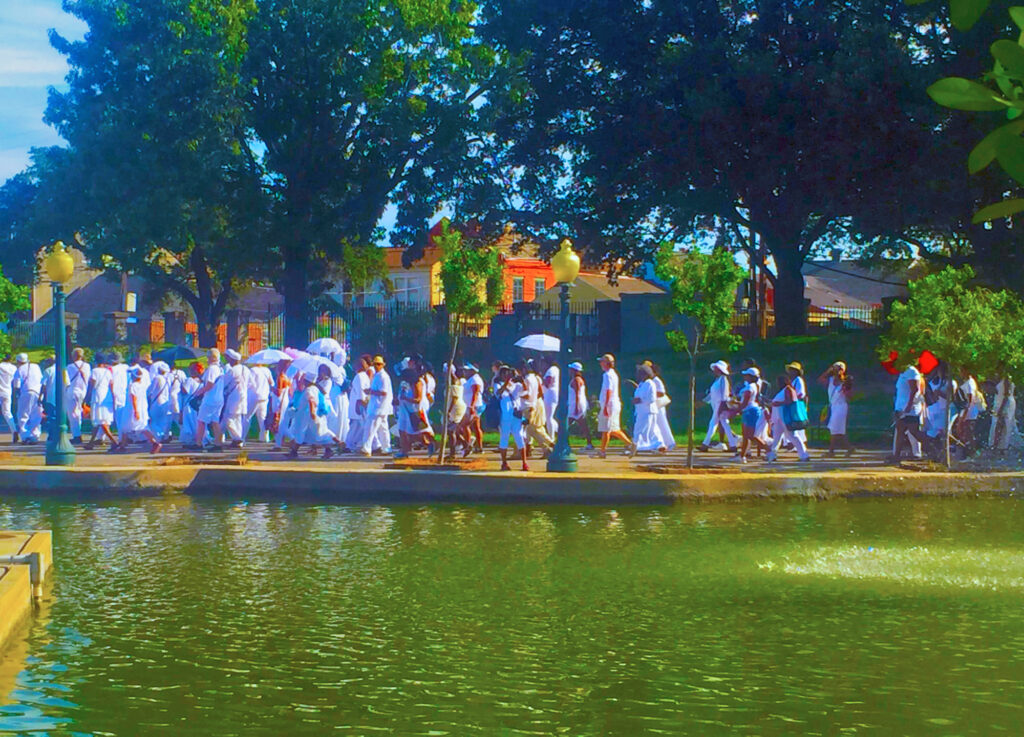The Middle Passage Ceremonies and Port Markers Project (MPCPMP) was formed in 2011 to advocate for the commemoration of the lives of enslaved Africans at U.S. locations where they first arrived after surviving the ocean voyage called the Middle Passage. This is a history that begins in 1526, when the first shipment of captive Africans disembarked in the Sapelo Bay region of Georgia on the Atlantic coast. MPCPMP highlights that year as the starting point of Middle Passage history and African slavery on the North American mainland.
Over the years, we have learned that there is no cookie cutter version to describe centuries of forced migration and slavery—no simple way to tell this narrative of place. It is the story of a nation shaped and grounded within a racially defined caste system.
Along the way, this initiative has been embraced by many but has also encountered resistance, for example those advocating for ownership of the story and determining who should be included and how. That is a constant challenge. The simplest way to tackle this is by researching facts going as far back as possible in the story of place. We must acknowledge those who have lived before and those living now so that the focus is on “place as a community of people.” Then, the next step is to share what has happened in this place, this nation, over time.
At those arrival sites where Middle Passage history and slavery occurred, all is not cut and dried. After all, this is the United States of America, where the motto on our currency proclaims “From many, one.”
Until well into the early and mid-19th century, not only Africans but also non-Europeans comprised the bulk of the population. In fact, the first law establishing slavery, instituted by the Massachusetts colony in 1641, targeted First Nation people. The other English colonies followed and expanded those under the yoke of slavery to include non-Christians, Africans, and those with African mothers. As the Native population resisted European invasion and territorial encroachment, their subsequent attacks and conflicts ultimately created prisoners of war. Many were enslaved; others were transported to British-controlled Caribbean islands; a small number were even sent to Europe.
The Project strongly recommends that the local First Nation community, as the original inhabitants, be a key component of the ancestral commemorations and marker installations. We suggest that they be asked to grant permission for the event as an acknowledgement of their connection to the history of place and, according to their traditions, that they cleanse the designated area before the ceremony or marker dedication as well as share their history and culture.
No matter our individual perceptions, there are few ethnically pure persons on this land. Most of us have ancestors who took part in this history – some as victims and others as perpetrators. This is an acceptance of reality, not a means of dilution. We are so conditioned by a racial caste system – “the one drop rule” – that we frequently fail to envision ourselves as people with a mixed and shared heritage spanning centuries.
Specifically among First Nation people, not only were both Europeans and Africans accepted into their communities, but entirely new tribes were formed that reflected this “mixed” heritage such as the Seminoles in Florida and the Yamasee of South Carolina and Georgia.
At one time, Huey Long, governor of Louisiana from 1928-1932, jokingly said that a nickel’s worth of red beans and a dime’s worth of rice would feed all of the pure whites in his state. That is applicable today to the entire nation. To reinforce and maintain white supremacy, dominance, and power, laws have been established defining race and placing people in categories that do not reflect complete ancestry. Over time, any nuances of color and heritage have been reduced to simple white, black, red, and yellow. This makes discrimination and segregation much easier to manage.
One ancestral group does not have to be selected over another to define ourselves. We can highlight individual and group presence and contributions, but the spotlight has to be across the board, not exclusive or restricted.
Middle Passage Ceremonies and Port Markers Project promotes the inclusion of a portion of this nation’s history – the Middle Passage – that has been omitted from the narrative. We will not engage in any effort that enables or encourages the exclusion of any people who share this history of place, no matter their ethnicity or heritage. It will take radical imagination, rethinking, and work to evolve into an anti-racist America. MPCPMP is one step in the process of reconciling, healing, and redefining the history of place and the people who build community.

